
The blue whale is a marine mammal and a baleen whale. Reaching a maximum confirmed length of 29.9 meters (98 ft) and weighing up to 199 tonnes, it is the largest animal known ever to have existed. The blue whale's long and slender body can be of various shades of greyish-blue dorsally and somewhat lighter underneath. Four subspecies are recognized: B. m. musculus in the North Atlantic and North Pacific, B. m. intermedia in the Southern Ocean, B. m. brevicauda in the Indian Ocean and South Pacific Ocean, B. m. indica in the Northern Indian Ocean. There is also a population in the waters off Chile that may constitute a fifth subspecies.

Mackerel is a common name applied to a number of different species of pelagic fish, mostly from the family Scombridae. They are found in both temperate and tropical seas, mostly living along the coast or offshore in the oceanic environment.

Spartina is a genus of plants in the grass family, frequently found in coastal salt marshes. Species in this genus are commonly known as cordgrass or cord-grass, and are native to the coasts of the Atlantic Ocean in western and southern Europe, north-western and southern Africa, the Americas and the islands of the southern Atlantic Ocean; one or two species also occur on the western coast of North America and in freshwater habitats inland in the Americas. The highest species diversity is on the east coasts of North and South America, particularly Florida. They form large, often dense colonies, particularly on coastal salt marshes, and grow quickly. The species vary in size from 0.3–2 m tall. Many of the species will produce hybrids if they come into contact.

Chamidae, common name the jewel boxes or jewel box clams, is a taxonomic family of saltwater clams, a group of marine bivalve mollusks in the order Venerida.
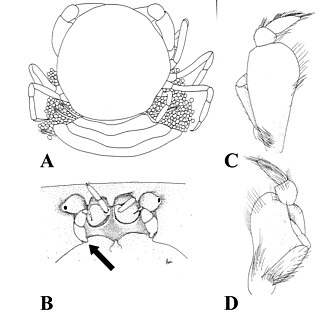
Gemmotheres also known as the jewel-box pea crab, is a monotypic genus of pea crab, which was erected in 1996 to hold the species Gemmotheres chamae. The species lives as a commensal of the corrugate jewelbox, Chama congregata.

Musculus niger, or the black mussel, is a species of bivalve mollusc in the family Mytilidae. It can be found in the Atlantic Ocean, eastern Pacific Ocean, and the Arctic Ocean. Along the Atlantic coast of North America, it ranges from the Arctic Ocean to North Carolina.

Lithophaga aristata, or the Scissor date mussel, is a species of bivalve mollusc in the family Mytilidae. It can be found along the Atlantic coast of North America, ranging from North Carolina to Texas and the West Indies.

Euvola is a genus of marine bivalve mollusks in the family Pectinidae, the scallops. In shells of this genus, one valve is flat, and the other is deeply cupped.
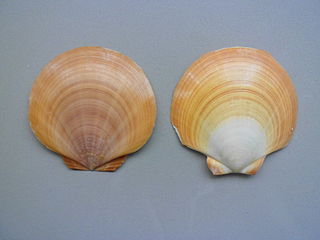
Euvola marensis, or the paper scallop, is a species of bivalve mollusc in the family Pectinidae. It can be found in the Gulf of Mexico, ranging from the West Indies to Brazil.
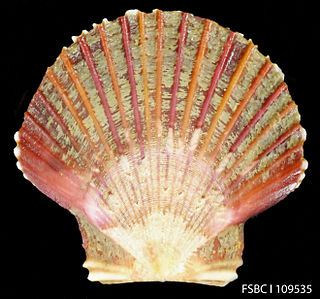
Euvola raveneli, or Ravenel's scallop, is a species of bivalve mollusc in the family Pectinidae. It can be found along the Atlantic coast of North America, ranging from North Carolina to the West Indies.
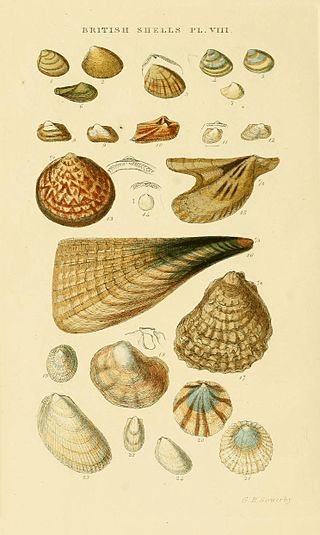
Limaria pellucida, the Antillean file shell, is a species of bivalve mollusc in the family Limidae. It can be found along the Atlantic coast of North America, ranging from North Carolina to the West Indies.

Spondylus americanus, the Atlantic thorny oyster, is a species of bivalve mollusc. It can be found along the Atlantic coast of North America, ranging from North Carolina to Brazil.
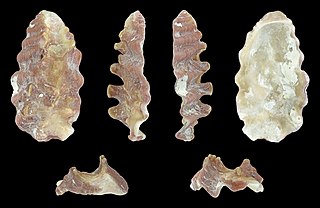
Dendostrea frons, the frond oyster, is a species of bivalve mollusc in the family Ostreidae.

Astarte elliptica, or the "elliptical astarte", is a species of bivalve mollusc in the family Astartidae. It can be found along the Atlantic coast of North America, ranging from Greenland to Massachusetts.
Clathrolucina costata, or the costate lucine, is a species of bivalve mollusc in the family Lucinidae. It can be found along the Atlantic coast of North America, ranging from North Carolina to the West Indies.

Chama macerophylla, or the leafy jewel box clam, is a species of bivalve mollusc in the family Chamidae.
Chama sarda, or the Cherry jewel box clam, is a species of bivalve mollusc in the family Chamidae. It can be found along the Atlantic coast of North America, ranging from southern Florida to the West Indies.

Chama sinuosa, common name the smooth-edged jewel box, is a species of bivalve mollusc in the family Chamidae, the jewel boxes. This species is found along the Atlantic coast of North America, from southern Florida to the West Indies.

Chama is a genus of cemented saltwater clams, marine bivalve molluscs in the family Chamidae, the jewel boxes.

Pseudochama is a species of bivalve mollusc in the family Chamidae.


















